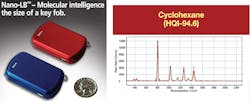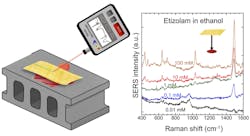Nano-sized Raman spectrometers promise a colorful future
The spectrometer has been the backbone of all optical measurements and characterizations since its invention in 1814. It’s used in many fields, including food safety, agriculture, astrophysics, space exploration, environmental monitoring, clinical diagnostics, and drug development.
Over time, optical spectrometer design has greatly improved—it can achieve incredible spectral coverage, resolution (<10-4 cm-1), and sensitivity, and can track ultrafast events (>1 MHz), thanks to complementary metal-oxide semiconductor (CMOS) technology. The once-rudimentary spectrometer has been transformed into a high-quality instrument, but its basic architecture had not changed significantly until just a few years ago.
Today, new applications are on the horizon, enabled by the development of advanced and extremely compact spectrometers.
A growing market for shrinking spectrometers
Within the next 10 years, the development of key markets will rely heavily on the ability to make compact high-quality spectrometers (see Fig. 1). This cannot be achieved using classical spectrometers; instead, it will require extremely compact and portable devices.
Newer designs and innovations show it is feasible to overcome previous size and portability limitations and build micron-sized spectral devices. These compact devices, combined with the latest electronics and detectors, are expected to be realized in a proven and cost-effective way in the near future. Integrated spectral devices will expand our knowledge of events and processes and be available to everyone at extremely low cost, opening the door to many new and exciting spectrometer applications.
A market analysis by Tematys in 2021 states: “the first aim of the development of compact spectrometers was to bring the lab measurements to the field or into the process line.”1
This objective not only increased the use of spectrometers in optical characterizations, pharmaceutics, and biotechnology, but also introduced spectrometers to new fields such as precision farming, recycling, and process control.
The overall spectrometer market was $11.04 billion in 2021 and is expected to increase at an average 5.9% compound annual growth rate (CAGR) until 2030.2
In comparison, Tematys’s projections for the specific compact spectrometer market (mini, micro, and chip size) through 2024 are predicted to be up to 111% CAGR. Much of the growth is expected to be from the expansion of spectrometers currently used primarily in research-based applications to a wider application in consumer and biomedical products, as well as optical characterization in chemistry, pharmaceuticals, chemicals detection, and food and beverage quality control. The markets for wearables, health monitoring, and implants will be highly impacted by compact spectrometers because weight and form factor are essential to creating new opportunities for these areas.
Spectrometer limitations
While standard spectrometers are widely available in laboratories and research facilities, where they can achieve very high accuracy and sensitivity, their use in the field remains a challenge— obtaining sufficient resolution requires space to disperse the light, leading to larger optical components, more weight, and an overall footprint that is too bulky for the field.
Many such spectrometers are used in research and in large facilities as static long-term instruments but cannot match the requirements of the rapidly expanding wearable and portable devices markets. Add in the need for lasers, electronics, and interface for any specific spectroscopic measurement, and their size and weight quickly become excessive.
Truly portable spectrometers
While standard spectrometers remain key in many applications, BaySpec has applied its extensive expertise with telecom and tabletop spectrometers to design a new device/spectrometer that will fit into an extremely compact footprint.
Building a compact spectrometer to use for wearable applications requires significant innovation to transition from the standard ~20-inch spectrometer box to a device that can fit into your pocket or even be integrated into a smartwatch or smartphone. While various labs are trying to solve this by using single-pixel spectrometer-like designs, combined with machine learning/reconstruction algorithms, this technology tends to require exotic materials, have narrow bandwidth, restricted workable wavelengths, and is still years away from being implemented into actual devices.
Spectrometers have become progressively miniaturized and improved during the past 20 years, starting from telecom spectrum-analyzing devices and moving into increasingly compact portable devices. Compact spectrometers now made by BaySpec can be ~15 grams and ~15 × 20 mm in size.
Nano-Raman wearable devices
While newly developed spectrometers are light and compact, useful applications require more. One extremely useful and versatile field instrument is the Raman spectrometer, which enables real-time analysis of numerous biochemicals in any light conditions. For real-life applications, a spectrometer must be coupled with the lasers, detector, electronics, processing power, and interface necessary for a full Raman measurement device.
To achieve such a compact instrument, BaySpec took a multifaceted approach that valued not only the optical miniaturization, but system-wide optimization and integration. As noted by BaySpec’s CEO William Yang, “the electronics team was especially valuable in enabling a compact device with very low power consumption.” Bluetooth connectivity is also integrated into each of these devices, which makes it easy to relay data and spectra on a mobile device.
Combining these elements as a Raman device results in a 59-gram instrument the size of a car key fob, with the ability to detect any molecule within the fingerprint region (450–2300 cm-1). This is the smallest and lightest Raman spectrometer on the market.
As shown in Figure 2, our spectrometer is quite compact and can be manufactured with different excitation wavelengths depending on applications. It takes measurements once per second and can be built into different packaging solutions. Generally, longer-wavelength laser options are more useful in biomedical applications, while shorter ones work best for the detection of chemical and biological warfare agents.Surprising array of applications
The applications for portable Raman spectrometers are quite varied—ranging from chemical detection, illicit drug testing, and food and pharmaceutical quality control to personal health monitoring, pesticide detection, urine measurements, and many biomedical applications.
To best cover all these applications, the devices are often repackaged and customized depending on the customer’s needs, which tend to come with some surprising and unexpected applications, as well.
One such application for these devices was reminiscent of a James Bond movie. BaySpec was asked to create a device in the same shape and size of a car key fob so it could be used by law enforcement agents to ascertain if surfaces or areas are contaminated by hazardous chemicals, and whether traces of illicit drugs are present.
Another significant market for such devices is organic fruit resale, in which it is important to check for the presence of pesticides in the final product. A small portable device is essential, especially for smaller shops and resale locations that cannot afford or find room for a large instrument. Even larger shops have found that the accuracy of the small devices is comparable to the large tabletop ones and can significantly streamline their quality control process.
The most common uses have been in hazardous chemical detection (law enforcement), pharmaceuticals, and food and produce quality control.
Racing toward the future with SERS
Recently, there’s been a lot of excitement around continuous monitoring of infectious disease propagation, bacteria, and aerosols within environments, but it has remained difficult to detect trace amounts before they become hazardous.
To overcome this, a surface-enhanced Raman spectroscopy (SERS) sensor, such as those developed by BaySpec, couples the nano-Raman spectrometer with an adhesive ~2- to 10-µm-thick substrate, which can be placed on any surface (see Fig. 3). The thin film is a specially deposited gold nanomesh structure carefully arranged to enhance the Raman signal through resonance—enabling greatly improved sensitivity for such chemicals and biomarkers that may otherwise be challenging to detect.3
One example is trace detection of the illicit drug Etizolam, as low as 0.01 mM (see Fig. 3). Portable SERS devices can be placed on often-touched surfaces such as doorknobs, so that presence of infectious diseases, drugs, or biochemicals may be monitored within buildings.The SERS method used by BaySpec enables in situ measurements with a durable, easy-to-apply nanomesh, compared to standard SERS, in which the chemical must be carefully deposited on a surface in the lab. This SERS nanomesh can also absorb and concentrate the measured molecules over time and provide longer-term monitoring.
Large-scale integration of Raman systems into portable/wearable devices and smartphones still faces challenges, but the markets indicate readiness and a significant interest in enabling real-time, highly sensitive measurements of all kinds of biochemicals. The evolving compact spectrometer technology and growing markets for their applications promise to have a real and positive impact on improving people’s lives.
REFERENCES
1. J. Kulakowski and B. d’Humières, “Compact Spectrometers: Technologies, Market Trends and Needs,” Photonics Views, 1 (2021).
2. See www.emergenresearch.com/industry-report/spectrometry-market.
3. Y. Kitahama et al., Anal. Methods, 15,1028–1036 (2023).
Daniel Lauriola | Spectroscopy Scientist, BaySpec
Daniel Lauriola, Ph.D., is a spectroscopy scientist at BaySpec (San Jose, CA).
![FIGURE 1. Market projections for miniature spectrometers until 2024, and main markets of influence [1]. FIGURE 1. Market projections for miniature spectrometers until 2024, and main markets of influence [1].](https://img.laserfocusworld.com/files/base/ebm/lfw/image/2023/02/2304LFW_lau_1.63fe5aa4106bb.png?auto=format,compress&fit=max&q=45&w=250&width=250)

